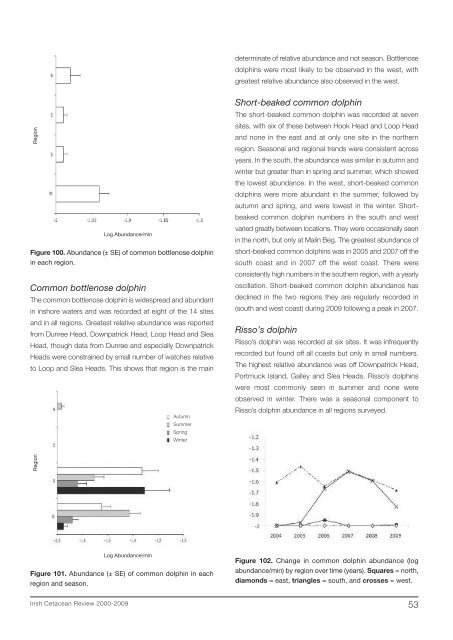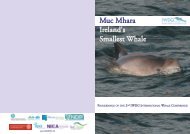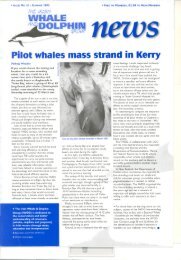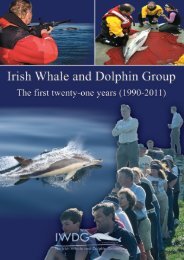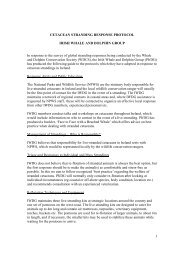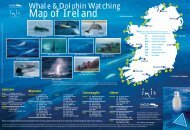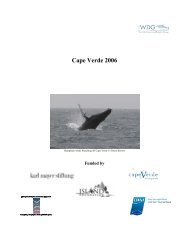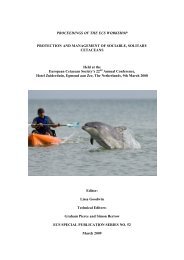downloaded here - Irish Whale and Dolphin Group
downloaded here - Irish Whale and Dolphin Group
downloaded here - Irish Whale and Dolphin Group
Create successful ePaper yourself
Turn your PDF publications into a flip-book with our unique Google optimized e-Paper software.
determinate of relative abundance <strong>and</strong> not season. Bottlenose<br />
dolphins were most likely to be observed in the west, with<br />
greatest relative abundance also observed in the west.<br />
Region<br />
Log Abundance/min<br />
Figure 100. Abundance (± SE) of common bottlenose dolphin<br />
in each region.<br />
Common bottlenose dolphin<br />
The common bottlenose dolphin is widespread <strong>and</strong> abundant<br />
in inshore waters <strong>and</strong> was recorded at eight of the 14 sites<br />
<strong>and</strong> in all regions. Greatest relative abundance was reported<br />
from Dunree Head, Downpatrick Head, Loop Head <strong>and</strong> Slea<br />
Head, though data from Dunree <strong>and</strong> especially Downpatrick<br />
Heads were constrained by small number of watches relative<br />
to Loop <strong>and</strong> Slea Heads. This shows that region is the main<br />
Autumn<br />
Summer<br />
Spring<br />
Winter<br />
Short-beaked common dolphin<br />
The short-beaked common dolphin was recorded at seven<br />
sites, with six of these between Hook Head <strong>and</strong> Loop Head<br />
<strong>and</strong> none in the east <strong>and</strong> at only one site in the northern<br />
region. Seasonal <strong>and</strong> regional trends were consistent across<br />
years. In the south, the abundance was similar in autumn <strong>and</strong><br />
winter but greater than in spring <strong>and</strong> summer, which showed<br />
the lowest abundance. In the west, short-beaked common<br />
dolphins were more abundant in the summer, followed by<br />
autumn <strong>and</strong> spring, <strong>and</strong> were lowest in the winter. Shortbeaked<br />
common dolphin numbers in the south <strong>and</strong> west<br />
varied greatly between locations. They were occasionally seen<br />
in the north, but only at Malin Beg. The greatest abundance of<br />
short-beaked common dolphins was in 2005 <strong>and</strong> 2007 off the<br />
south coast <strong>and</strong> in 2007 off the west coast. T<strong>here</strong> were<br />
consistently high numbers in the southern region, with a yearly<br />
oscillation. Short-beaked common dolphin abundance has<br />
declined in the two regions they are regularly recorded in<br />
(south <strong>and</strong> west coast) during 2009 following a peak in 2007.<br />
Risso’s dolphin<br />
Risso’s dolphin was recorded at six sites. It was infrequently<br />
recorded but found off all coasts but only in small numbers.<br />
The highest relative abundance was off Downpatrick Head,<br />
Portmuck Isl<strong>and</strong>, Galley <strong>and</strong> Slea Heads. Risso’s dolphins<br />
were most commonly seen in summer <strong>and</strong> none were<br />
observed in winter. T<strong>here</strong> was a seasonal component to<br />
Risso’s dolphin abundance in all regions surveyed.<br />
Region<br />
Log Abundance/min<br />
Figure 101. Abundance (± SE) of common dolphin in each<br />
region <strong>and</strong> season.<br />
<strong>Irish</strong> Cetacean Review 2000-2009<br />
Figure 102. Change in common dolphin abundance (log<br />
abundance/min) by region over time (years). Squares = north,<br />
diamonds = east, triangles = south, <strong>and</strong> crosses = west.<br />
53


